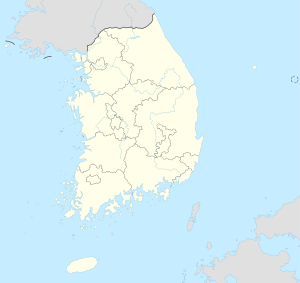Andong
| Andong | |||
|---|---|---|---|
| Korean alphabet : | 안동시 | ||
| Chinese characters : | 安 東 市 | ||
| Revised Romanization : | Andong-si | ||
| McCune-Reischauer : | Andong-si | ||
| Basic data | |||
| Province : | Gyeongsangbuk-do | ||
| Coordinates : | 36 ° 34 ' N , 128 ° 43' E | ||
| Surface: | 1,519 km² | ||
| Residents: | 184,108 (status: 2000) | ||
| Population density : | 121 inhabitants per km² | ||
| Structure: | 1 eup , 13 myeon , 10 dong | ||
| Postal code : | 36600-36760 | ||
| map | |||
|
|||
Andong ( kor. 안동 ) is a city in the South Korean province of Gyeongsangbuk-do . With just under 185,000 inhabitants, it is the largest city in the northern part of the province. The Nakdonggang flows through the city. Andong is a market center for the predominantly agricultural area.
history
During the period when Korea was part of the Japanese Empire (1910 to 1945), Japanese was the national language . The city therefore had the Japanese name Andō , which is the Japanese pronunciation of the written city name 安 東 .
Since the 1970s, Andong has developed rapidly, although the population has decreased by almost 70,000 as many residents moved to Seoul and other major cities. In the late 1990s it became a center for tourism and culture. Many old traditions are maintained in the surrounding area, such as the annual Andong Folk Festival in mid-October . One of its most famous aspects are the Andong masks.
The Andong National University , specializing in teacher training and Korean folk tradition, has grown significantly since the 1970s. Other universities include the Andong Institute of Information Technology , Andong Science College, and Catholic Sangji College .
Attractions
The city center of Andong is quite manageable. The "Speis-und-Trank-Straße" (음식 의 거리) can be reached via a decorative gate from the main street and only houses restaurants, some of which specialize in different dishes, including the steamed chicken variants, which are a local specialty. Not far from there is the Andong Market (안 동구 시장), which, with its covered passages, has a similar structure to the traditional markets in other Korean cities.

In the vicinity of the city, a trip to the area around the Andong Dam, which dams the Nakdonggang , Korea's longest river, is recommended. This is spanned by the " moonlight bridge " ( 월영교 ), which is the longest pedestrian bridge in Korea at 387 meters. Close by is the small but interesting folklore museum with the adjoining folklore village, which only consists of a few houses that were moved when the dam was built.
If you walk about a kilometer further up the mountain (past the restaurants), you will reach the filming location for a well-known KBC series set in the Joseon Dynasty . Behind a wide wall with an embedded gate are the backdrops of numerous traditional thatched and tile-roofed houses as well as the reconstruction of a small palace including a prison. The wide area and most of the buildings are free and unlimited as long as there is no filming. Part of the site is now used as a resort.
The folklore village of Hahoe , located about 24 kilometers west of the city, is recommended as a trip to the vicinity of Andong . In contrast to other villages of this type, people still live here in around 130 traditional houses. Most of them are therefore not open to visitors and are surrounded by high walls - but a few are free to visit.
sons and daughters of the town
- Yi Hwang (1501–1570), neo-Confucian scholar
- Kim Jong-gil (1926–2017), poet and writer
- Tachihara Masaaki (1926–1980), Japanese writer
- Kwon Yeo-sun (* 1965), writer
- Lee Jae-hyuk (* 1969), former boxer
- Lim Yong-kyu (* 1991), tennis player
- Cho Yoon-jeong (* 1979), former tennis player
- Kim Jin-kyu (* 1985), soccer player
Web links
- Official website (English)
